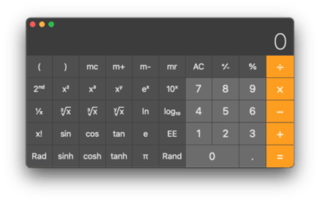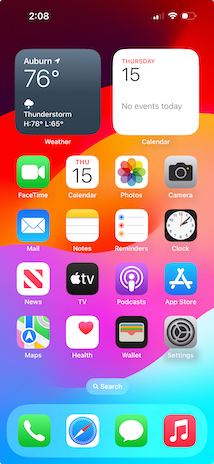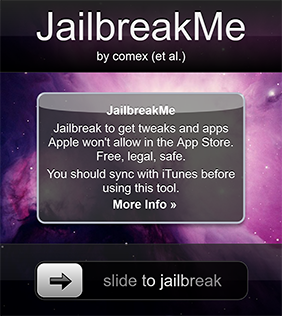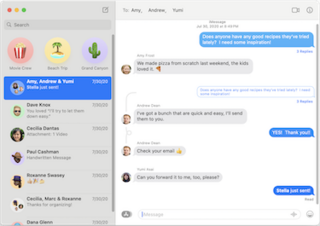
Privilege escalation is the act of exploiting a bug, a design flaw, or a configuration oversight in an operating system or software application to gain elevated access to resources that are normally protected from an application or user. The result is that an application with more privileges than intended by the application developer or system administrator can perform unauthorized actions.

Calculator is a basic calculator application made by Apple Inc. and bundled with its macOS, iOS, and watchOS operating systems. It has three modes: basic, scientific, and programmer. The basic mode includes a number pad, buttons for adding, subtracting, multiplying, and dividing, as well as memory keys. Scientific mode supports exponents and trigonometric functions. The macOS version of Calculator also has a programmer mode that gives the user access to more options related to computer programming.

The iPhone is a line of smartphones produced by Apple Inc. that use Apple's own iOS mobile operating system. The first-generation iPhone was announced by then-Apple CEO Steve Jobs on January 9, 2007. Since then, Apple has annually released new iPhone models and iOS updates. As of November 1, 2018, more than 2.2 billion iPhones had been sold. As of 2022, the iPhone accounts for 15.6% of global smartphone market share.

The iPod Touch is a discontinued line of iOS-based mobile devices designed and marketed by Apple Inc. with a touchscreen-controlled user interface. As with other iPod models, the iPod Touch can be used as a portable media player and a handheld gaming device, but can also be used as a digital camera, a web browser, for email and messaging. It is nearly identical in design to the iPhone, and can run most iPhone third-party apps from the App Store, but it connects to the internet only through Wi-Fi and uses no cellular network data since it lacks a cellular modem.

iOS is a mobile operating system based on macOS and on components of the Mach microkernel and FreeBSD, a Unix-like operating system, developed by Apple Inc. exclusively for its smartphones. It was unveiled in January 2007 for the first-generation iPhone, launched in June 2007.
SpringBoard is the standard application that manages the iPhone's home screen. Other tasks include starting WindowServer, launching and bootstrapping applications and setting some of the device's settings on startup.
iOS is a mobile operating system developed by Apple Inc. and was first released as iPhone OS in June 2007, coinciding with the launch of the first generation iPhone. iPhone OS was renamed iOS following the release of the iPad, starting with iOS 4. With iOS 13, Apple began offering a separate operating system, iPadOS, for the iPad. iOS is also the foundation of the newer audioOS and tvOS, and shares some of its code with macOS. New iOS versions are released every year alongside new iPhone models. From its launch in 2007 until 2010, this occurred in June or July, since then, new major versions are released in September or October. Since the launch of the iPhone in June 2007, there have been 17 major releases of iOS. The current major version of iOS is iOS 17, released in September 2023.
Absinthe is a distilled alcoholic beverage.
On Apple devices running iOS and iOS-based operating systems, jailbreaking is the use of a privilege escalation exploit to remove software restrictions imposed by the manufacturer. Typically it is done through a series of kernel patches. A jailbroken device permits root access within the operating system and provides the right to install software unavailable through the App Store. Different devices and versions are exploited with a variety of tools. Apple views jailbreaking as a violation of the end-user license agreement and strongly cautions device owners not to try to achieve root access through the exploitation of vulnerabilities.

Cydia is a graphical user interface of APT for iOS. It enables a user to find and install software not authorized by Apple on jailbroken iPhones, iPads and iPod Touch devices. It also refers to digital distribution platform for software on iOS accessed through Cydia software. Most of the software packages available through Cydia are free of charge, although some require purchasing.

The iPad is a brand of iOS and iPadOS-based tablet computers that are developed by Apple Inc., first introduced on January 27, 2010. The iPad range consists of the original iPad lineup and the flagship products iPad Mini, iPad Air, and iPad Pro.
A .ipa file is an iOS and iPadOS application archive file which stores an iOS/iPadOS app. Each .ipa file includes a binary and can only be installed on an iOS, iPadOS, or ARM-based macOS device. Files with the .ipa extension can be uncompressed by changing the extension to .zip and unzipping. This is only recommended when editing the app itself. Some ipa’s will not have a .app file.

Jay Ryan Freeman is an American businessman and software engineer. He is known for creating the Cydia software application and related software for jailbroken iOS—a modified version of Apple's iOS that allows for the installation and customization of software outside of the regulation imposed by the App Store system.
In computing, a SHSH blob is a digital signature that Apple generates and uses to personalize IPSW firmware files for each iOS device. SHSH blobs are part of Apple's protocol designed to ensure that only trusted software is installed on the device, generally only allowing the newest iOS version to be installable. Apple's public name for this process is System Software Authorization. The term “SHSH blob” is unofficial and based on abbreviations for signed hash and binary large object. An alternative term, ECID SHSH, refers to the device's ECID, a unique identification number embedded in its hardware)

JailbreakMe is a series of jailbreaks for Apple's iOS mobile operating system that took advantage of flaws in the Safari browser on the device, providing an immediate one-step jailbreak, unlike more common jailbreaks, such as Blackra1n and redsn0w, that require plugging the device into a computer and running the jailbreaking software from the desktop. JailbreakMe included Cydia, a package management interface that serves as an alternative to the App Store. Although it does not support modern devices, it can still be used and the site is up.

The iPad 2 is a tablet designed, developed and marketed by Apple Inc. Compared to the first iPad, as the second model in the iPad line, it gained a faster dual core A5 processor, a lighter build structure, and was the first iPad to feature VGA front-facing and 720p rear-facing cameras designed for FaceTime video calling.

iMessage is an instant messaging service developed by Apple Inc. and launched in 2011. iMessage functions exclusively on Apple platforms - including macOS, iOS, iPadOS, and watchOS - as part of Apple's broader strategy of vendor lock-in.

The iPad is a tablet computer, developed and marketed by Apple Inc. The third device in the iPad line of tablets, it added a Retina Display, the new Apple A5X chip with a quad-core graphics processor, a 5-megapixel camera, HD 1080p video recording, voice dictation, and support for LTE networks in North America. It shipped with iOS 5, which also provides a platform for audio-visual media, including electronic books, periodicals, films, music, computer games, presentations and web browsing.
The Pangu Team, is a Chinese programming team in the iOS community that developed the Pangu jailbreaking tools. These are tools that assist users in bypassing device restrictions and enabling root access to the iOS operating system. This permits the user to install applications and customizations typically unavailable through the official iOS App Store.
The iOS mobile operating system developed by Apple Inc. It has had a wide range of bugs and security issues discovered throughout its lifespan, including security exploits discovered in most versions of the operating system related to the practice of jailbreaking, bypassing the user's lock screen, issues relating to battery drain, crash bugs encountered when sending photos or certain Unicode characters via text messages sent through the Messages application, and general bugs and security issues later fixed in newer versions of the operating system.











